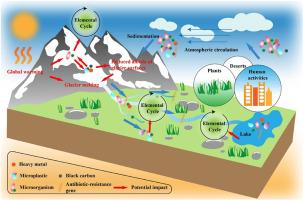IF 4.4
Q1 ENVIRONMENTAL SCIENCES
引用次数: 0
摘要
然而,保护冰川相关栖息地的行动迫在眉睫,因为人类活动已导致冰川退缩加剧,并可能对气候和下游环境平衡产生影响。冰川包含多种栖息地(冰、雪、冰芯、脱冰土壤等),其中蕴藏着丰富的微生物群落(冰川生命活动的主要载体)。除了描述微生物的起源、多样性、适应性和生物地球化学循环外,我们还强调了环境污染物和气候变化的作用。已有研究表明,外源微生物可以通过大气环流沉积在冰川上。冰川特殊的地质气候特征可能促使这些微生物通过进化和合作来适应这种极端环境。这些微生物参与了冰川中生物元素的循环,为地球的生态系统提供反馈。然而,环境污染的增加可能会影响冰川微生物。一些污染物与气候变暖协同作用,加速冰川融化,融水携带微生物、营养物质和污染物进入下游生态系统,可能对下游生态系统和全球气候产生深远影响。本文章由计算机程序翻译,如有差异,请以英文原文为准。

Glacial microbial-environmental interactions on the Tibetan Plateau: A review
The glaciers on the Tibetan Plateau are important climate regulators and recharge sources for many rivers and lakes, which are of great ecological value. However, actions to protect glacier-associated habitats are urgent, as human activities have led to increased glacier retreat and may have an impact on climate and downstream environmental balance. Glaciers contain a variety of habitats (ice, snow, cryoconite, deglaciated soil, etc.) that harbor rich microbial communities (the main bearers of glacial life activities). To provide scientific support for the development of glacier protection strategies on the Tibetan Plateau from a microbial perspective, this review reveals the interactions between glacial microorganisms and glacial ecosystems on the Tibetan Plateau. In addition to describing the origin, diversity, adaptability and biogeochemical cycles of microorganisms, we emphasized the roles of environmental pollutants and climate change. It has been shown that exogenous microorganisms can be deposited on the glacier by atmospheric circulation. The special geo-climatic characteristics of glaciers may have prompted these microorganisms to adapt to this extreme environment through evolution and cooperation. These microorganisms are involved in the cycling of biogenic elements in glaciers, providing feedback to the Earth's ecosystem. However, increased environmental pollution may affect the glacier microorganisms. Some pollutants synergize with climate warming to accelerate glacial melting, with meltwater carrying microorganisms, nutrients, and pollutants into downstream ecosystems, which may have far-reaching impacts on downstream ecosystems and the global climate. Reducing source pollution, strengthening international cooperation, implementing long-term monitoring, developing predictive models, and tapping into special microorganisms are the way forward in guarding the clean land of the Tibetan Plateau glaciers in the future.
求助全文
通过发布文献求助,成功后即可免费获取论文全文。
去求助

 求助内容:
求助内容: 应助结果提醒方式:
应助结果提醒方式:


